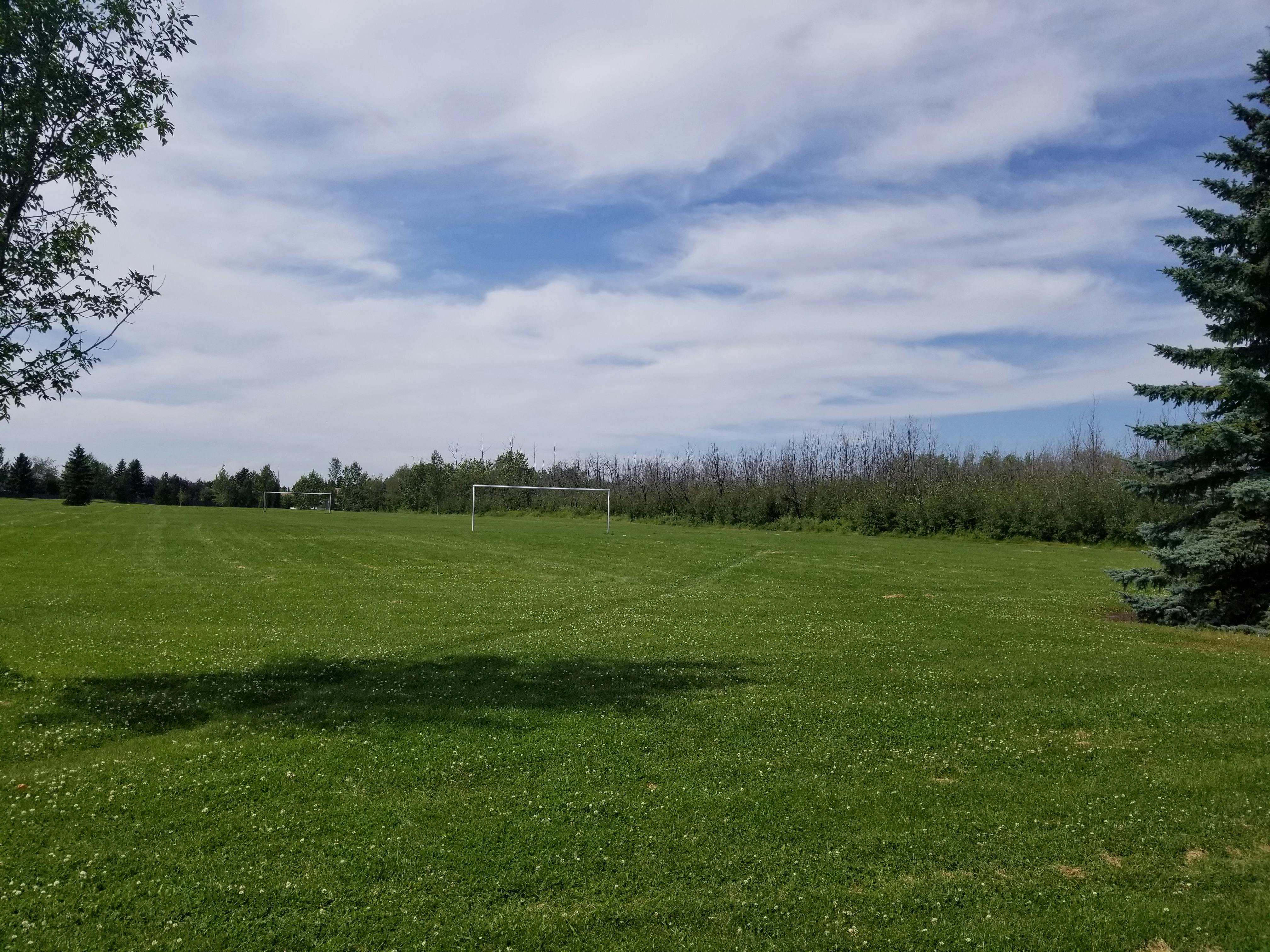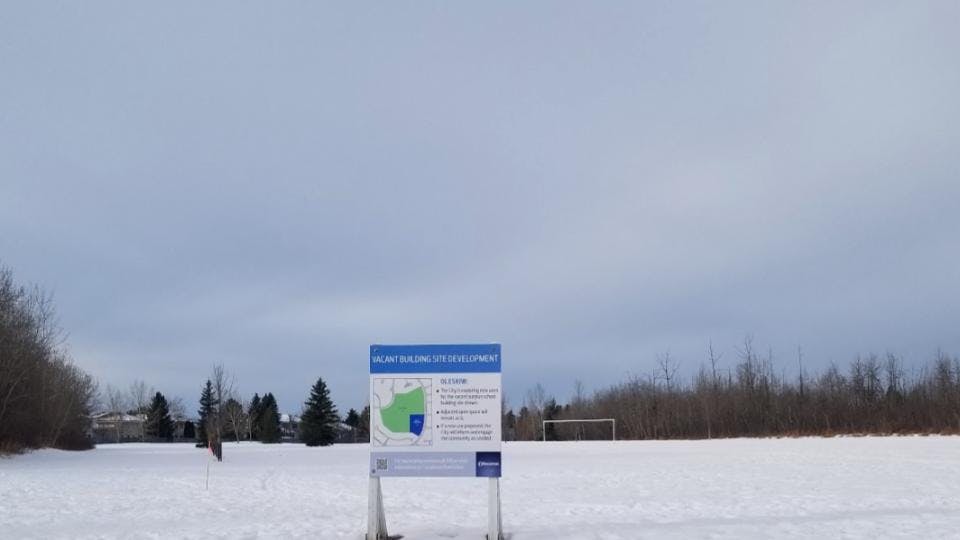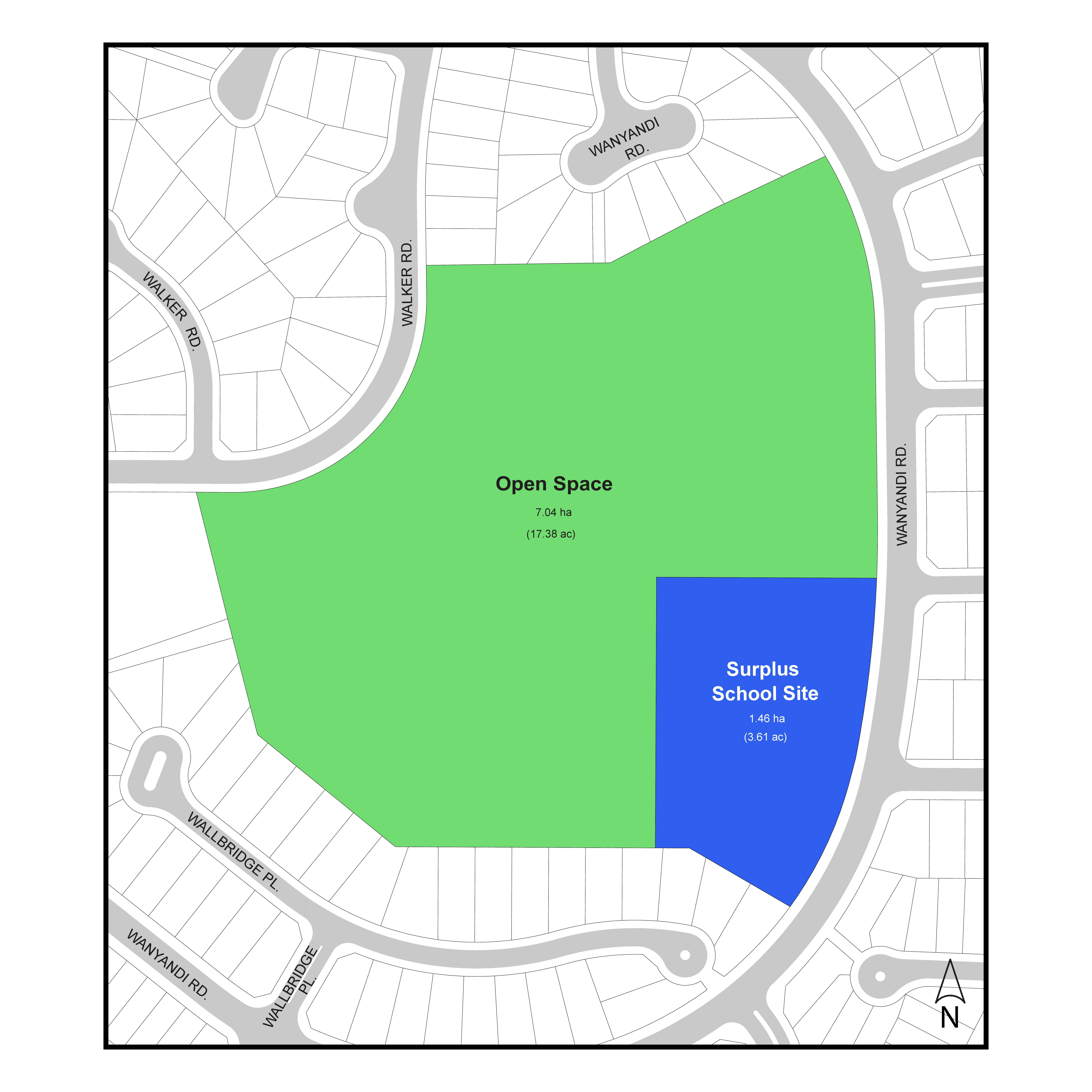Oleskiw Surplus School Site Zoning Options
Consultation has concluded

***The discussion has concluded and a What We Heard Report is now available.***
Thank you for providing feedback for consideration.
***The discussion has concluded and a What We Heard Report is now available.***
Thank you for providing feedback for consideration.
You can:
Ask a question directly to the project team.
Search and view community-submitted questions and official responses.
Type your question in the box below and click "Submit". Answers are provided as soon as possible, and timing can depend on the number of questions received.
-
A response to an earlier question was that "The Oleskiw neighbourhood includes approximately 119.74 hectares of publicly owned and/or accessible open space." However, based on City sources, the Oleskiw Neighbourhood is only 132ha in total. Therefore, how is it possible that it contains 120 ha of accessible open space? Or, are you perhaps referring to the steep slopes leading to the river that surrounds the neighbourhood? The vast majority of this area does not seem "accessible" nor can it be programmed to support the facilities that Oleskiw Park currently provides (e.g. sports fields, play park, rare table land natural area, open space for other programming and recreation). Can you please outline how much of this 120 ha can be programmed similarly to what is possible in Oleskiw Park? A map would be helpful as well. Thank you.
CGhodsi asked about 3 years agoThanks for your question.
This 119.74 hectares of open space does include portions of the river valley in close proximity to Oleskiw. The Urban Parks Management Plan cites a minimum target of 2.0 hectares of parkland/1000 people. If we restrict our analysis to the school site (excluding the surplus area) the neighbourhood park adequacy would be as follows: 7.3 Ha school site (this excludes the 1.46 surplus area) / 2,869 residents in neighbourhood (2019 census) to derive a figure of 2.54 Ha per 1000 residents. This is still above the Urban Parks Management Plan standard.
Below is a map for your reference of the 119.74 hectares of open space calculated for the Oleskiw neighbourhood. Though you are right that some of this open space does not provide the same facilities and opportunities that Oleskiw Park has, it also provides additional recreational opportunities that Oleskiw Park may not.
 open spaceopen space
open spaceopen space -
Can you provide a fourth zoning option that would protect this land as a natural area? ie. The natural Areas Protection Zone
JOAN BANNER asked about 3 years agoSelecting the ‘Other’ response in the survey and providing a brief explanation that you would like to see the area rezoned to the Natural Areas Protection Zone (NA) would let us know your preference.
We did not include a fourth choice with the NA zone as an option as we are focused on residential uses for the site, as these were seen to fit best within the surrounding community and work toward higher density targets as outlined in the City Plan and Edmonton Metropolitan Region Growth Plan. Additionally, as the site was designated for a school building originally in the Oleskiw Park Site Development Master Plan, the intent of the site was always to be developed for non-park uses.
open space,natural areaopen space natural area -
Will our drastically reduced Public Transit (bussing) be reviewed if this area has increased density and activity?
Lisa Bossert asked about 3 years agoThank you for your feedback.
As you are aware, the Bus Network Redesign is implementing changes in transit service to the neighbourhood in April 2021. Transit routes are monitored according to ridership. A neighbourhood would need to experience a significant increase in ridership in order for additional frequency to be added. Transit Planning reviews Land Development Applications for these impacts and there may be an opportunity to change the level of service; however, Transit Planning has stated that a residential development on the proposed surplus school site would not create enough demand to warrant increased service.
transit servicetransit service -
It would be a shame to destroy this greenspace. It is the only greenspace that this community has to enjoy. Although only a section has been shown that will be developed, can we be assured the rest of the greenspace will be saved and not targeted for development in the future?
P Hammond asked about 3 years agoOnly the school building site that was declared surplus by the Edmonton Public School Board is being proposed for development, and the remaining space will stay as open space.
The City may consider relocating or reconfiguring the specific development location on site if there is community support for that and it must be financially and technically feasible, but the size of the development location will remain the same.
open spaceopen space -
What are the factors considered in determining the type of rezoning options available? How much weight do the current residents living in the zone have in determining the type of rezoning? Were there earlier decisions made? I had thought we had determined that multifamily housing were voted down? Thanks.
J & J Nash asked about 3 years agoSimilar to private developers, City Administration reviews the development potential of any surplus land based on several factors including, but not limited to: site size and configuration, servicing information, environmental information, geotechnical information, surrounding land uses, and overarching Strategic Plans such as the City Plan and the Edmonton Metropolitan Region Growth Plan. Administration is recommending medium density residential uses on this site to make most efficient use of the site while maintaining compatibility with the adjacent land uses, as well as meeting Edmonton’s Strategic Policies to provide more density and a range of housing in established neighbourhoods.
Survey responses and comments from residents will influence the decision on which zone will be submitted.
This is the first step in moving towards a Land Development Application to rezone the property, and there has been no vote or community engagement prior to this.
public engagement,processpublic engagement process -
We do not need high rises in an area that has been delegated for a school. What a sham and travesty for the home owners that have been there for over 30 years. What gives the city the right to do such development when all along it was scheduled for a school. Perhaps I could live with a senior complex or a senior development like what is in country club so RMD is the only thing that I would vote for. Many people use this area for their dogs and for soccer and playing. Why not leave it as a on leash dog park and a mixed area for children, families, and teams to play and practice. It certainly would add to the green footprint and lessening of the carbon footpring == we do not need more traffic along Wanyandi Road. How can I vote for this? Will there be an open debate and plebiscite or will it be the city's way or nothing? so much for democracy.
Susanne Leveille asked about 3 years agoThank you for your comments.
The zoning options provided have maximum heights of 4 stories for RMD, 3 stories for RF5 and 5 storeys for RA7.
Additionally, there will be another opportunity for residents to provide feedback during the rezoning process and an opportunity for community members to speak directly to City Council at a public hearing. City Council has the final say on whether the rezoning application is approved or not.
height,open space,trafficheight open space traffic -
The Engage Edmonton website states "Development of the site for medium density residential uses supports Edmonton’s Strategic Plan, the City Plan, and Reimagine goals for supporting infill development." Please outline what policies direct that the City is to prioritize infill over improving parkland? Developing infill on parkland is not innovative - it is regressive at best. More innovative approaches include lot splitting, granny suites, alley homes, etc. and are more likely to get the City to its infill goals faster than sacrificing 1.4 ha of valued natural area forest and parkland to medium density residential development. Please more clearly articulate what policies suggest converting parkland to residential is the best way to achieve all the big city moves (including Greener as we grow and supporting the Green and Blue Network).
NYoosef asked about 3 years agoAs you have correctly pointed out, the City Plan, ConnectEdmonton, and other plans have climate resilient and environmental goals. There are also policies and goals to support infill and increased density, a few policy directives from the City Plan that support infill include (but are not limited to):
1.3.3.4 Enable all districts to achieve more income-diverse neighbourhoods and a greater mix of land uses.
2.2.1.6 Enable ongoing residential infill to occur at a variety of scale, densities and designs within all parts of the residential area.
There are choices, like the rezoning and sale of surplus school sites, that require a balanced approach to these guiding documents. Not every decision the City makes can advance all of the strategic goals. Rezoning and sale of surplus school sites requires a balanced approach to the City’s guiding documents, meeting some (but perhaps not all) of the City’s strategic goals.
The City believes that repurposing undeveloped, surplus building sites makes the best and most innovative use of available land with existing infrastructure to offer greater housing choices to everyone, creating more sustainable communities and better meeting the City’s changing needs.
infill,open spaceinfill open space -
I have a clarification question related to one of the City responses provided to another question. Your response was: "In response to your concerns about property values, the Realtors Association of Edmonton has stated: “There are frequent claims from local residents that the addition of various facilities, amenities, businesses, or alternative housing types in their community will have a negative effect on the value of property in the community. Overwhelming evidence from studies in Canada and the U.S., indicates that the assumption that house prices will fall is false." Please include the reference to this study so that interested community members can review. In addition, please also confirm that this study specifically showed that a conversion of parkland (i.e. natural forest and recreational space) to residential did not have a negative impact on property values. I have a strong suspicion that this was not the example explored in the studies that are referenced.
CGhodsi asked about 3 years agoTo clarify, this was just a statement that was issued from the Realtors Association of Edmonton based on their knowledge and research. It was not a full study that was conducted.
For a bit more information on property values, and development of surplus school sites there is additional information as it relates to the City’s First Place program, which is a similar development on a surplus school site:
City staff monitor First Place sites each year to determine if the market value of properties located next to First Place sites respond differently than properties located next to undeveloped surplus school sites in other neighbourhoods. To date, staff have found no distinguishable assessment change between properties located next to First Place building sites and those located next to undeveloped surplus school sites in other neighbourhoods. The City continues to monitor these First Place areas annually. The City’s Assessment and Taxation branch has reviewed sales data from across the City gathered for taxation assessment purposes from 2010 to 2015. They have advised that First Place townhomes will not have any significantly different impact on adjacent property value than that of the school originally planned for the building site.
Please note the Oleskiw surplus school site is not intended for the First Place Program and the land would be sold for market value and developed by whoever purchases the land. The above information is solely to provide more information on the assessed values of properties located next to other developed surplus school sites
land valueland value -
Why is the City not educating the community about the City managed Natural Area (NW638) that is on the site and why is the option to permanently protect it (now that there is no need to hold the land for a school building) not presented as a zoning option for the community to consider? Such tableland natural areas are very rare in the City - they should be prioritized for protection, not sacrificed to infill development that could be more appropriately handled elsewhere (e.g. lot splitting, granny suites, garden homes, alley homes, etc).
NYoosef asked about 3 years agoThank you for your comment. You are correct, this was a missed opportunity to provide the community with additional information about the Oleskiw tree stand. The City-Wide Natural Area Management Plan has been added to the engagement site for the remainder of this engagement.
That said, this site was always intended as a development site and when it was declared surplus by the school board in 2015 it did not revert to exclusively parkland but was intended to be a developable site within the City’s land inventory. Unfortunately, the trees located within the development boundary were not intended to be permanent and may need to be removed as part of the site redevelopment.
environmentenvironment -
It is really unclear from this Engaged Edmonton website how the Community's feedback will (or will not) inform future considerations for this parkland. Right now it only looks like after the What We Heard report is released any Administration decision will bypass the community and go straight to LDA submission. Is that really the process? The community only has three weeks to consider the fate of a park that has been in existence, and we have used, for 40 years?
NYoosef asked about 3 years agoThanks for your question.
Once the engagement has closed, which has been extended to March 16, the project team will compile and analyze all information gathered through the engagement. With that information the City will examine concerns raised by the community and make any adjustments required to the application.
The City will look to connect with the community league to make them aware of the progress of this project and the next steps as this process progresses.
There will be another round of engagement during the rezoning process for the community to provide feedback. This will include an opportunity for community members to speak directly to City Council at a public hearing.
This current engagement process is in addition to the standard rezoning engagement, as the City wanted to connect with the community before submitting a rezoning application to ensure community awareness and gather feedback.
engagement,timingengagement timing
Tell us how we did!
Provide your feedback on digital public engagement activities.
Stay Informed
Click here to share your email address to get the What We Heard Report emailed to you when complete.
For more information about registering to stay engaged with other City projects and initiatives, visit the Engaged Edmonton FAQ page.
Who's Listening
-
Phone 780-442-1376 Email jennifer.smyth@edmonton.ca
ADVISE
ADVISE
This means the City asks the public to share feedback and perspectives that are considered for policies, programs, projects, or services.
ROLE OF THE PUBLIC
Document Library
FAQs
- Why was a school never built at the site?
- Why does the City want to develop the surplus school site?
- Are barriers to park access considered in the site location?
- Can’t a different surplus school site in another neighbourhood be developed instead?
- Will the soccer field located on the surplus school site be replaced?
- Can the surrounding roadways handle more traffic generated from the development site?
- Will my property value decline due to this development?
- Is there sufficient drainage capacity?
- Can the development be relocated elsewhere on the park site?
- How are the sale proceeds used?
- Why do we need other types of housing?
- What about the impacts to the Oleskiw tree stand?
Timelines
-
Pre-Application Notification
Oleskiw Surplus School Site Zoning Options has finished this stageFebruary 2021 - Notification postcard informing of online zoning options engagement mailed to Ozerna residents.
-
Pre-Application Engagement
Oleskiw Surplus School Site Zoning Options has finished this stageFebruary 16th-March 16th - Engagement for zoning options occurs online at Engaged Edmonton.
-
What We Heard Report
Oleskiw Surplus School Site Zoning Options has finished this stageApril, 2021 - What We Heard Report summarizing feedback received from pre-application engagement and highlighting which zoning option is being moved forward is released publicly.
-
Land Development Application (LDA) Submission
Oleskiw Surplus School Site Zoning Options is currently at this stageTo Be Determined - The selected zoning option is submitted for rezoning along with the required plan amendments and subdivision applications. The submitted applications undergo technical review to ensure concerns are addressed before being recommended to Council.









